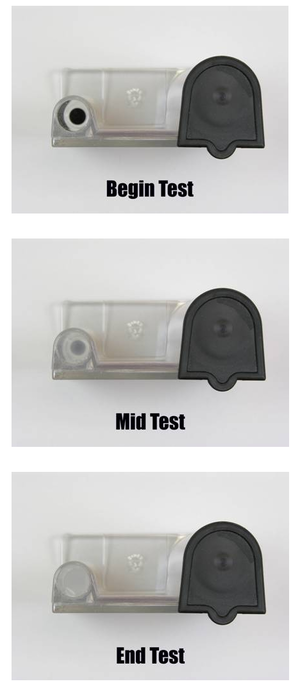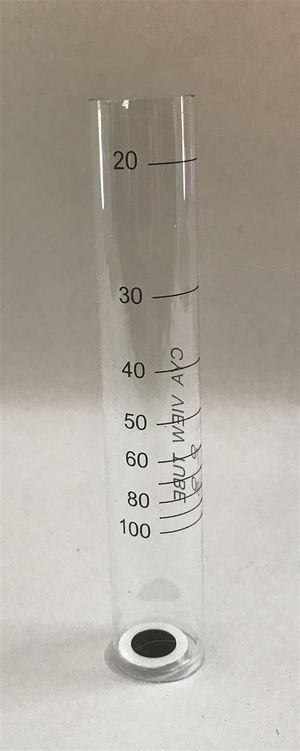CYA Testing
Follow the instructions for CYA Testing in Pool School. Read all of the notes in the Pool School article.
Many people find the CYA test to be the most difficult test to interpret and get consistent results.
The CYA test is a turbidimetric test and, the least "accurate" of any of the tests in your kit because everyone will interpret "when the black dot just disappears" differently--regardless of techniques and even using the same sample water! That's why there's no need to be specific when trying to get an answer.[1]
Don’t agonize over the CYA test. Just call it as you see it.
Light Conditions Matter For Reading the Dot
As much as possible you should do the CYA test in the same consistent light conditions:
- Outside in full sun or use the brightest indirect indoor light that you can if you have to test at night
- Back to sun
- Don't stare at the dot as you pour
- Fill to a line, hold the tube waist high, and glance at the dot
- If you see the dot fill to the next line and glance at the dot
- When the dot disappears you round up to the previous line. If you saw the dot at 40 and not at 30 then you call it 40
After reading, you can pour mixture back into the mixing bottle and try it again; repeated readings on the same sample will lend confidence in the result.
What the CYA Test Dot Should Look like
The pictures are from Taylor Technologies and illustrate how the dot should look.
In the Taylor images, you can see something but it's not the black dot. It's the bottom of the tube. If you look closely, the black dot is smaller than the bottom of the tube (diameter wise) and the dot is clearly not visible.[2]
CYA Test Results of +/-20PPM is Okay
We use this test to figure out your Free Chlorine level using the FC/CYA Chart. With a CYA level of 30 you want your FC between 2-6ppm. With a CYA level of 50 you want to stay between 4-8ppm. There's really not a huge difference between the "goals". Even with a huge margin of error on the CYA test, if you keep the FC between 4-6 you're 100% safe.[3]
CYA Viewing Tube Scale is Logarithmic
The spacing between the lines on CYA viewing tubes varies and is not linear. Halfway between lines in not 5. You cannot interpolate values between the lines.
Always round up to the previous line. If you saw the dot at 40 and not at 30 then you call it 40.
Cold Test Water Should be Room Temperature for CYA Test
If the water temperature is below 70F degrees let the water warm up inside before you do the CYA test.
The standard instructions to mix for 30 seconds is not enough time when the water is cold. You can either mix longer, or warm up the sample to room temperature. Best solution is to warm the sample first and then use 30 seconds.[4]
Taylor Technologies has run the pH, total alkalinity, calcium hardness, free chlorine, and cyanuric acid tests on known standard solutions at approximately 104°F, 75°F, 60°F, and 40°F. Only at 40°F did the CYA standard solution test higher than its actual value (after accounting for test variability). All other tests were unaffected by temperature differences.[5]
The melamine solution that is used in the better tests is at low pH so as to force the maximum precipitation of melamine cyanurate since it is somewhat soluble at pH 7.0 with a solubility of around 20 ppm. There is no question that at colder temperatures it will take longer to precipitate.[6]
Does it Matter if You Wait Longer Then 30 Seconds Before Reading the CYA Test?
Up to five minutes is fine and I suspect that you can go longer and still get accurate results.[7]
TF-100 vs K-2006 CYA Test Differences
The view tube for the TF-100 does use a larger sample size and it goes down to 20 ppm instead of only 30 ppm as the K-2006 does.[8]
It is a bad idea to mix testing reagents and hardware between different testing kits.
CYA Standard Solution
You can buy CYA 50 Standard Solution to practice on and see what the dot should look like at the CYA 50 end point.
Directions for R-7065 (CYA 50 Standard Solution)
1. Fill the red-capped CYA mixing bottle to the bottom of the label with R-7065 (it is the “pool water”). Now, fill the bottle to the top of the label with R-0013 (in 8 oz. bottle).* Mix then wait at least 30 seconds. Mix once more.
2. Next, get the clear tube marked CYA View Tube and holding it at waist level (so you can look down into tube) slowly fill the view tube with the solution you have mixed. Keep filling until you no longer see the black dot in the bottom of the tube. *You should have a reading of 50 ppm, give or take 5 ppm.
Tips
- The test is designed to be performed in bright sunlight and will read low if you use indoor lighting.[9]
- You want to make sure that the test vial and black dot are clean. If there is any residue obscuring the black dot, then that will throw off the accuracy of the test.[10]
- For the TF-100 CYA test you use about 14 ml of equal amounts of R-0013 and pool water
.
- ↑ https://www.troublefreepool.com/threads/cya-testing-taylors-response.141025/post-1246870
- ↑ https://www.troublefreepool.com/threads/cya-testing-just-disappears-seems-subjective.48937/post-411573
- ↑ https://www.troublefreepool.com/threads/cya-testing-just-disappears-seems-subjective.48937/post-411581
- ↑ https://www.troublefreepool.com/threads/at-what-water-temp-is-cya-test-reliable.55271/post-466588
- ↑ https://www.taylortechnologies.com/en/page/105/questions-in-our-poolspa-mailbag
- ↑ https://www.troublefreepool.com/threads/at-what-water-temp-is-cya-test-reliable.55271/post-466493
- ↑ https://www.troublefreepool.com/threads/at-what-water-temp-is-cya-test-reliable.55271/post-466627
- ↑ https://www.troublefreepool.com/threads/cya-test.119086/post-1054048
- ↑ https://www.troublefreepool.com/threads/at-what-water-temp-is-cya-test-reliable.55271/post-467157
- ↑ https://www.troublefreepool.com/threads/cya-testing-just-disappears-seems-subjective.48937/post-412512



